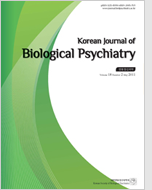
- Past Issues
- e-Submission
-

2021 Impact Factor 1.766
5-Year Impact Factor 1.674
Editorial Office
- +82-01-9989-7744
- kbiolpsychiatry@gmail.com
- https://www.biolpsychiatry.or.kr/

2021 Impact Factor 1.766
5-Year Impact Factor 1.674
Korean Journal of Biological Psychiatry 2010;17(1):44-8. Published online: Jan, 1, 2010
Objectives:Social phobia is frequently accompanied with autonomic nerve system symptoms. QT dispersion(QTd) is the maximum inter-lead difference in QT interval, an indicator of the autonomic nerve system(ANS) disparity of the heart itself. The objective of this study is to investigate the ANS disparity, which is measured by QTd, is associated with pathophysiology of social phobia.
Methods:This research have compared QT dispersion of 25 physically healthy social phobia outpatients(16 men, 9 women, the average age 35.5 ± 12.9) and age and sex matched control group of mentally and physically healthy 25 volunteers(16 men, 9 women, the average age 34.83 ± 12.7). QTd was measured by previously described method.
Results:QTd and rate-corrected QTd were significantly higher on the patient group than the control group[QTd(patients vs. controls:52.60 ± 27.63ms vs. 27.53 ± 14.29ms, p<0.0001), QTd(patients vs. controls:55.79 ± 27.98ms vs. 29.10 ± 14.24ms, p<0.0001)].
Conclusion:Our study showed that the patients with social phobia have higher QTd than the normal controls. These results suggest that the ANS disparity, which is measured by QTd, is associated with pathophysiology of social phobia.
Keywords QT dispersion;Social phobia;Autonomic nerve system.